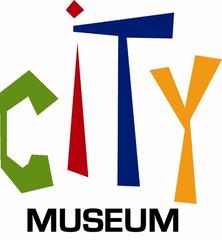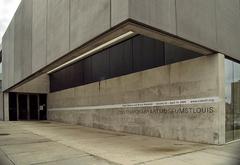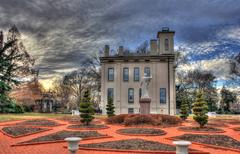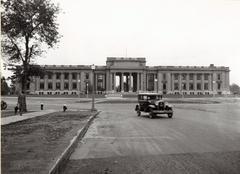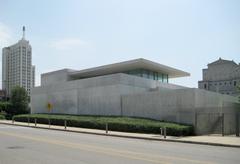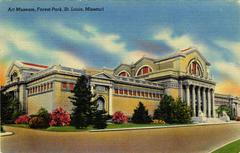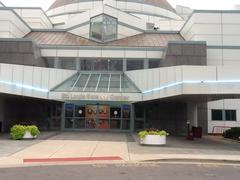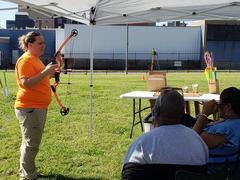Vigo Park St. Louis: Visiting Hours, Tickets, and Travel Guide
Date: 14/06/2025
Introduction
Vigo Park, nestled within the vibrant city of St. Louis, Missouri, serves as a cherished urban green space blending historical depth, natural beauty, and community amenities. Established during the early 20th-century urban reform era, Vigo Park continues the city’s legacy of providing accessible green havens amidst bustling neighborhoods. Despite its modest size compared to icons like Forest Park, Vigo Park is a sanctuary for relaxation, recreation, and cultural reflection in the heart of St. Louis (Wikipedia: History of St. Louis; Mapcarta: Vigo Park).
The park’s significance is amplified by its roots in the development of the Visitation Park neighborhood and connections to the historic Visitation Academy. Visitors to Vigo Park encounter a welcoming environment, interpretive historical signage, and convenient access to major city attractions such as the Missouri Botanical Garden, Gateway Arch, and Forest Park’s renowned museums and zoo (Living St. Louis; Explore St. Louis).
This comprehensive guide details Vigo Park’s visiting hours, accessibility, travel tips, outdoor activities, integration with the city’s park system, and suggestions for making the most of your visit. Whether you seek tranquil nature walks, family-friendly activities, or a deeper connection with St. Louis’s rich heritage, Vigo Park is an urban retreat not to be missed (Vigo County Parks Activities; Explore St. Louis Visitors Guide).
Contents
- Early Development of St. Louis Parks
- Origins and Naming of Vigo Park
- Visiting Information: Hours, Accessibility, and Travel Tips
- Nearby Attractions and Connectivity
- Integration with St. Louis’s Park System
- Community Events and Cultural Significance
- Natural Landscape and Ecological Features
- Terrain and Vegetation
- Water Features
- Wildlife and Birdwatching
- Outdoor Activities
- Essential Visitor Information
- Vigo Park: Events & Visitor Guide
- Vigo Park: Historical Significance & Integration with St. Louis Attractions
- Suggested Itineraries
- Frequently Asked Questions (FAQ)
- Summary and Travel Advice
- References
Early Development of Parks in St. Louis
St. Louis’s commitment to public parks arose from 19th and early 20th-century urban planning and reform movements. As the city expanded after the Civil War, officials recognized the need for green spaces to enhance public health and community cohesion. The formalization of the city’s park system began in the 1870s, culminating in landmark projects like Forest Park, which opened in 1876 (Wikipedia: History of St. Louis).
Throughout the early 1900s, under the leadership of Parks Commissioner Dwight F. Davis, St. Louis prioritized the development of neighborhood parks, playgrounds, and recreational amenities. Vigo Park emerged from this movement, providing critical green space and recreational opportunities to its surrounding community.
Origins and Naming of Vigo Park
Located near neighborhoods such as Clifton Heights, Ellendale, and Tower Grove South, Vigo Park’s name likely honors a historical figure or place, following local tradition, though specific documentation is limited (Mapcarta: Vigo Park). Its creation was integral to St. Louis’s early efforts to bring green, recreational sanctuaries into residential districts, offering respite from urban life and spaces for community gatherings.
Visiting Information: Hours, Accessibility, and Travel Tips
- Visiting Hours: Open daily from dawn to dusk.
- Admission: Free; no tickets required.
- Accessibility: Paved, wheelchair- and stroller-friendly paths; benches and shaded areas for resting.
- Parking: Street parking is available but may be limited during peak times. Consider public transit or rideshare.
- Travel Tips: Bring water, wear comfortable shoes, and check the weather before your visit.
For up-to-date information on accessibility or special features, consult the St. Louis Parks and Recreation official website.
Nearby Attractions and Connectivity
Vigo Park’s central location provides easy access to several of St. Louis’s premier attractions:
- Missouri Botanical Garden: Historic gardens and conservatories.
- Saint Louis Science Center: Interactive exhibits for all ages.
- Forest Park: Home to the St. Louis Zoo, Art Museum, and Missouri History Museum.
- Gateway Arch: Iconic national monument and museum.
These sites, along with local dining and shopping options, enrich the experience for Vigo Park visitors (Explore St. Louis).
Integration with St. Louis’s Park System
Vigo Park is part of a broad network of parks in St. Louis, blending grand spaces like Forest Park with neighborhood oases. Influenced by the City Beautiful movement, this system contributes to the city’s livability, offering accessible recreation and natural beauty throughout the metro area (Wikipedia: History of St. Louis).
Community Events and Cultural Significance
While Vigo Park primarily hosts neighborhood-scale events—such as block parties and recreational programs—it is part of a citywide tradition of vibrant outdoor festivals, including the St. Louis African Arts Festival and Forest Park’s Balloon Glow (Explore St. Louis: Fairs and Festivals). Community events foster local connections and celebrate the city’s diverse heritage.
Natural Landscape and Ecological Features
Terrain and Vegetation
Vigo Park features rolling meadows, mature hardwoods (oak, maple, sycamore), native shrubs, and seasonal wildflowers. These habitats support pollinators and small mammals, creating an oasis for both wildlife and visitors.
Water Features
A scenic pond, ringed by an accessible path, is home to aquatic plants and supports fish species like bluegill, catfish, and bass, making it a popular catch-and-release fishing spot. The pond also attracts waterfowl and aids in urban stormwater management (Vigo County Parks Activities).
Wildlife and Birdwatching
Vigo Park is frequented by squirrels, rabbits, and songbirds such as robins, cardinals, and woodpeckers. Migratory birds pass through during spring and fall, enhancing its appeal for birdwatchers. Interpretive signage educates visitors about the park’s flora and fauna (Vigo County Parks Activities).
Outdoor Activities
- Walking, Hiking, and Running: Paved and gravel trails, accessible and well-marked, with routes for all fitness levels.
- Biking: While the park’s trails are pedestrian-focused, nearby parks offer dedicated biking facilities and regional trail connections (Vigo County Parks Activities).
- Fishing: The pond is stocked and suitable for family-friendly catch-and-release fishing.
- Playgrounds and Sports: Modern playgrounds and open fields for informal sports.
- Picnicking: Scattered tables and reservable shelters with grills and nearby restrooms.
- Birdwatching & Nature Walks: Prime in early mornings and late afternoons; occasional guided walks are available.
- Seasonal Activities: Spring wildflowers, summer recreation, fall foliage, and tranquil winter scenes.
For boating and kayaking, nearby larger parks like Hawthorn and Fowler Park offer additional options (Vigo County Parks Activities).
Essential Visitor Information
- Accessibility: ADA-compliant paths, accessible restrooms, designated disabled parking, and amenities for visitors with varied abilities.
- Travel Tips: Free parking near entrances; public transit maps available for planning.
- Nearby Historical Sites: Missouri Botanical Garden, Forest Park, Gateway Arch—all within easy reach.
- Special Events: Community events and guided programs are posted on the Vigo County Parks website.
- Photo Spots: Sunrise/sunset at the pond, fall foliage, and wildlife areas are popular for photography.
Vigo Park: Events & Visitor Guide
- Facilities: Restrooms, water fountains, picnic tables, barbecue grills, bicycle racks, and a café with light meals.
- Accessibility: ADA pathways, ramps, adaptive playground equipment, tactile paving, and induction loops.
- Safety: Park rangers patrol regularly, emergency call boxes, and well-lit pathways.
- Seasonal Notes: Summer brings festivals and concerts; shaded areas and misting stations help with the heat.
- Family Features: Fenced play areas, family restrooms, bottle refill stations, and reservable group shelters.
Vigo Park: Historical Significance & Integration with St. Louis Attractions
Historical Context
Formerly Visitation Park, this site originated from the grounds of the Visitation Academy, founded in 1858 and converted to public use after the academy relocated. The park’s history is preserved through markers and educational panels (Living St. Louis).
Access to Major Attractions
- Forest Park: Museums, zoo, trails, and more (Nomadasaurus).
- Central West End: Historic mansions, dining, and nightlife.
- Delmar Loop: Walk of Fame, music venues, eclectic shops.
- Missouri Botanical Garden & Tower Grove Park: Horticultural displays and Victorian landscaping.
- Downtown/Gateway Arch: The city’s iconic landmark and vibrant entertainment (Explore St. Louis).
Suggested Itineraries
- Half-Day Heritage Tour: Vigo Park → Saint Louis Art Museum → Central West End.
- Full-Day Family Adventure: Vigo Park → St. Louis Zoo → Science Center → Delmar Loop.
- Cultural/Botanical Day: Vigo Park → Missouri Botanical Garden → Tower Grove Park.
Frequently Asked Questions (FAQ)
Q: What are Vigo Park’s hours?
A: Daily from dawn to dusk. Some guides list 6:00 AM–10:00 PM; check official listings for current times.
Q: Is there an entrance fee?
A: No, the park is free to enter.
Q: Are pets allowed?
A: Yes, on leashes. Please clean up after your pet.
Q: Is Vigo Park wheelchair accessible?
A: Yes, paved and ADA-compliant paths are available.
Q: What facilities are available?
A: Restrooms, playgrounds, picnic shelters, fishing pond, walking trails.
Q: Are there events or guided tours?
A: Community events are held occasionally; check the Vigo County Parks website for event details.
Summary and Travel Advice
Vigo Park exemplifies St. Louis’s ongoing dedication to inclusive, accessible, and historically significant public spaces. Its blend of natural features—rolling meadows, mature trees, and a peaceful pond—offers a restorative haven for visitors of all backgrounds. The park’s storied past, rooted in the Visitation Academy and neighborhood, enhances its role as a community landmark (Living St. Louis; Wikipedia: History of St. Louis).
Located near major attractions and equipped with a full suite of accessible amenities, Vigo Park is an ideal base for an authentic St. Louis adventure. Whether you’re seeking relaxation, recreation, or a connection to the city’s heritage, Vigo Park is a must-visit. For updates and tips, explore official resources and download the Audiala app for personalized guidance (Explore St. Louis Visitors Guide; Audiala app).
References
- Wikipedia: History of St. Louis
- Mapcarta: Vigo Park
- Vigo County Parks Activities
- Explore St. Louis Visitors Guide
- Living St. Louis: Historic St. Louis Neighborhoods
- Explore St. Louis
- Audiala App
Plan your visit today, share your experiences with #ExploreVigoPark, and make the most of your time in St. Louis’s vibrant green spaces!


